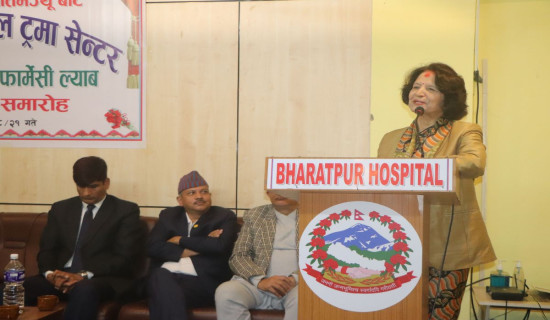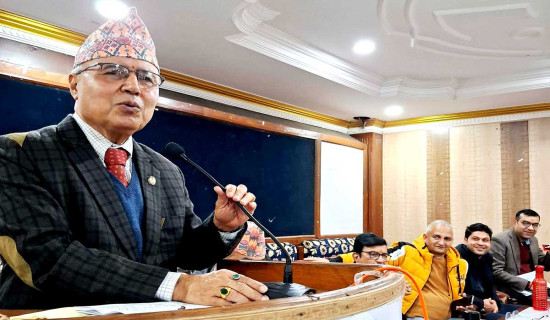- Monday, 8 December 2025
Challenges and Progress Of Gender Equality in Nepal
Approximately half of the global population consists of women. Throughout history, women have grappled with inequality, subordination, and second-class status, enduring oppression and exploitation within patriarchal societies. These challenges persist in both developed and developing nations, demonstrating the enduring nature of the issue. Despite efforts in modern and postmodern societies, gender equality often remains a mere slogan. Feminism arose to confront traditional injustices against women and challenge a male-dominated perspective.
The origins of feminism trace back to the 1848 Seneca Falls Convention in the United States, a pivotal event advocating for women's rights. It wasn't until 1920 that women gained the right to vote in the United States. Over the 20th century, feminism evolved into a global movement, advocating for "Gender Equity," which encompasses equal access, benefits, and decision-making power for men and women across families, societies, and states. Feminist theory delves into the essence, origins, and strategies to liberate women from subordination, dissecting its root causes.
Feminist activists have tirelessly campaigned for fundamental legal rights, including property rights, contractual rights, and voting rights. They have also fought against domestic violence, sexual harassment, and rape, advocating workplace rights such as maternity leave and equal pay. Additionally, feminists advocate for bodily autonomy, reproductive rights, and the inclusion of feminist discourse in theoretical and philosophical arenas, further deepening the understanding of gender equality.
Distinct branches of feminism have emerged, each with its focus and goals. Liberal feminism emphasises equal rights and benefits for men and women. Radical feminism attributes women's oppression to patriarchy, while Marxist feminism pins it on capitalism and patriarchy, analysing it through a class-based lens and recognising the value of household labour. Social feminists combine class and gender considerations, seeking to address both patriarchy and capitalism. Ecofeminism spotlights the connection between patriarchy and ecology. Newer concepts like cultural feminism, black feminism, and postmodern feminism have also gained prominence.
Cultural feminism underscores the differences between men and women and aims to create women's-exclusive spaces. Black feminism empowers black women in their unique pursuit of social justice. Postmodern feminism criticises a heterosexual, male-dominant society as a source of women's oppression. In Nepal, feminism takes various forms, including liberal feminism, cultural feminism, and intersectional feminism.
In Nepal, liberal feminism has been instrumental in shaping gender-equality policies and legislation, including the Citizenship Act and Domestic Violence Act. Cultural feminism manifests through efforts to preserve traditional arts and crafts associated with women. Intersectional feminism plays a pivotal role in addressing the challenges faced by marginalised Nepali women, such as dalit women, indigenous women, and those from rural areas, by dismantling intersecting forms of oppression and promoting inclusivity.
Feminist movement in Nepal
In Nepal, remarkable strides have been made in the realm of gender equality and women's empowerment over the past two decades. Notably, women's participation in politics has reached commendable levels across all three tiers of government. The nation's commitment to women's involvement is enshrined in various articles, mandating at least one-third representation of women in the federal parliament (Article 84-8), province parliament (Article 176-9), and a substantial 40 per cent presence of women in local government (Articles 220-3, 222-3, 223-3). This mandate extends to leadership positions, requiring alternating appointments of both men and women as speakers and deputy speakers in the national (Article 92-1, 2) and provincial parliaments (Article 182-2).
Notably, the implementation of Nepal's new constitution in 2016 witnessed a significant leap for women's empowerment. This pivotal moment saw three distinguished women ascend to the highest echelons of the state apparatus: Bidhya Devi Bhandari assumed the presidency, Onsari Gharti became the parliament speaker, and Sushila Karki assumed the position of Chief Justice in the Supreme Court. These historic appointments not only emboldened women's presence in key governmental roles but also catalysed a psychological transformation, fostering a heightened sense of competence and confidence among women at large. This, in turn, contributed to a shifting gender perspective within society.
Women's involvement extends beyond politics. Encouragingly, women's engagement in the civil service and private sectors has gained momentum, with approximately 22 per cent of working-age women employed in Nepal. Bolstering this progress is Nepal's constitution, which guarantees equal rights for both genders. Fundamental rights such as the right to equality, justice, and social security have special provisions for women, further solidifying their rights. These provisions are translated into action through a range of legislative measures, regulations, policies, and programmes.
The trajectory of women's empowerment has evolved. In the 1970s, the concept of "women in development" emerged to amplify women's participation in development processes and harness their untapped potential. Following democratic reforms in 1990, women's voices gained prominence in politics, public discourse, and academia. Subsequently, national plans underscored the importance of women's contributions across sectors. The Ninth National Plan in 1997 emphasised women's participation in administration, agricultural extension, credit access, education, and self-employment activities. The Government Reform Programme of 2001 introduced targeted measures, including candidate reservations, gender-sensitive curriculum design, sexual harassment protections, and family-friendly work policies.
The transformative political movement of 2006 expanded the scope of gender equity. Notably, one-third of the members elected to the constituent assembly were women, a milestone that positioned Nepal as a global leader in inclusive representation. Subsequent national plans continued to bolster women's inclusion and participation. The Interim Plan for 2007–2010 prioritised gender-sensitive development programmes, initiatives for conflict-affected women, and sector-wide female involvement. The Fourteenth Plan (2016–2018) facilitated women's meaningful participation across political, economic, and administrative spheres, while the Fifteenth Plan (2019–2024) aims to institutionalise gender-responsive governance and enhance women's access to resources and decision-making roles. In tandem with constitutional provisions and national plans, Nepal has established the National Women's Commission, integrated gender perspectives into local government programmes, and enacted anti-discriminatory legislation. Advocacy efforts and awareness campaigns, along with the alignment of gender-related Millennium Development Goals (MDGs) and Sustainable Development Goals (SDGs), underscore Nepal's ongoing commitment to mainstreaming women's participation and empowerment across all sectors of development.
Achievement of gender equality
Nepal's transformative journey towards inclusion is evident in its federal parliament, provincial assemblies, and local bodies. This robust trend of inclusion represents a subtle revolution, reshaping societal power dynamics and leadership structures. The remarkable inclusion of women, with representation exceeding 33 per cent at all legislative levels, signifies a remarkable shift. Additionally, some key parliamentary committees are now helmed by women. Over the past two decades, the Nepali security forces have also witnessed a growing influx of women, both in numbers and in higher positions. A parallel emergence of women entrepreneurs, industrialists, and bankers within the private sector underscores this evolving landscape.
In the realm of public service, women's participation has experienced a significant uplift. Previously limited to a modest presence of approximately 8 per cent before 2007, women's engagement gained momentum following the 1993 amendment to the Civil Service Act. This amendment reserved 45 per cent of open competition seats for historically excluded groups, including women. Consequently, the trajectory of women in public service has experienced a steady climb, rising from 11.09 per cent in 2008 to 23.6 per cent in 2017. Projections indicate that if the current momentum persists, the Nepali civil service is poised for a balanced gender distribution with a 50:50 ratio by 2037. This prediction hints at a promising future where women will occupy more top leadership positions. In the wake of an enduring democratic movement, women now assume diverse roles across various echelons. Contemporary policies and theories emphasise inclusivity, gender equality, and positive discrimination, marking a significant societal shift. These policy-driven transformations are tangible. The civil service sector, for instance, now comprises 27 per cent women, reflecting the successful implementation of affirmative action policies. Local bodies have also made strides, with 42 per cent women represented in elections, though questions linger about the extent of their leadership versus representational roles. Looking through the lens of philosophy and civilization, historical deities like Parbati, Laxmi, Saraswati, Durga, and Kali have been revered and cherished, protecting society's fabric. Despite this rich heritage, women's progress has not paralleled men's in keeping with changing times and societal development.
Challenges in implementation
Despite the formulation of numerous policies, plans, and initiatives aimed at fostering women's empowerment and gender development, the institutional framework for managing these endeavours remains notably frail. The execution of women's development programmes tends to be disjointed, lacking a cohesive approach. Regrettably, the targeted benefits designated for women occasionally fall prey to exploitation by other groups. Additionally, a pervasive ailment of 'invisibility' clouds the recognition of women's substantial contributions to the economy, particularly within household and informal sectors. Gender policies, though adopted, often bear the semblance of token gestures and superficial enhancements, neglecting to address the deeply entrenched causes of gender-based discrimination and bias. At times, the notion of gender mainstreaming appears to be an exclusive catchphrase, failing to resonate with the majority of rural women who, within the country's fabric, continue to grapple with discrimination, marginalisation, and deprivation.
Despite discussions about feminism, the grip of patriarchal ideologies persists stubbornly. The transformation of society's perception remains incomplete, as women's talents and education still encounter scepticism and lack full acceptance. Compounding these challenges is the inadequate allocation of resources, with insufficient budgetary support directed towards women's empowerment initiatives. Nepal's journey towards achieving gender equality and empowering women has encountered obstacles due to inadequate institutional frameworks, disjointed programme execution, and a lack of effective measures to challenge deeply rooted prejudices. True progress demands a more integrated, comprehensive approach that acknowledges women's contributions, confronts patriarchal norms, and allocates adequate resources for meaningful change. In the present era, the essence of feminism lies in advocating for equal rights and opportunities across all genders. It's crucial to view feminism not as an opposing force to patriarchy but rather as a call for justice and equality that encompasses everyone. The idea that "nobody is free until everybody's free" underscores the inclusive nature of feminism, transcending boundaries to promote fairness universally.
A progressive feminist movement goes beyond conventional boundaries of class, caste, and gender, embracing intersectionality to recognise the diverse array of identities and experiences. Intersectional feminism highlights the distinct challenges that women face due to factors such as race, class, ethnicity, religion, and sexual orientation. This comprehensive approach is the driving force behind true societal transformation.The feminist movement has undeniably emancipated women, yet it has also sparked counter-resistances that challenge its role in development paradigms. Despite the advancements, Nepal grapples with persistent hurdles on its path to complete gender equality. Deep-seated patriarchal norms, gender-based violence, child marriage, and limited healthcare access in rural areas stand as formidable barriers. To surmount these challenges, fostering awareness and sensitization among all segments of the population, including men and boys, is imperative. Challenging gender stereotypes and championing gender equality require collective efforts. Legal reforms, educational initiatives, amplified political representation, and the unwavering dedication of activists have collectively contributed to dismantling gender barriers in Nepal. While progress is evident, sustained commitment is necessary to overcome the remaining obstacles. By doing so, Nepal can pave the way for a society where every woman enjoys a life defined by dignity, equality, and empowerment. The journey towards gender equality demands persistence, unity, and the continued unwavering commitment of society at large.
(The author is an Architect and is working as an Urban Planner at the Bharatpur Metropolitan City office.)





-square-thumb.jpg)











